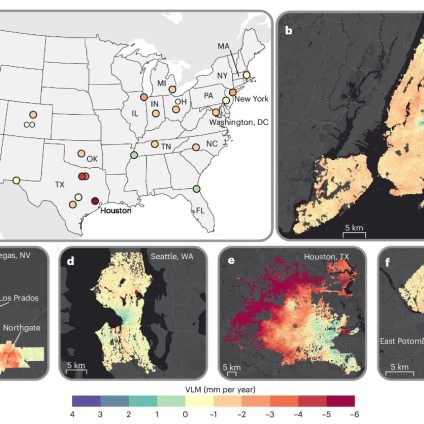Flooding, building collapses, and infrastructure at risk: the consequences of land subsidence affecting many major U.S. cities are serious and dangerous.

From New York to Denver, the map of land subsidence
Large U.S. cities are sinking. The ground beneath millions of Americans is slowly but steadily lowering, increasing the risk of flooding and causing less visible but equally dangerous damage to buildings and infrastructure.
Land subsidence, the gradual sinking of the ground, is not a new topic. However, a recent study led by Columbia Climate School offers the most detailed map to date of U.S. cities experiencing this phenomenon. Researchers analyzed satellite data for every U.S. city with over 600,000 residents, measuring vertical ground movement with millimeter precision using a 28-square-meter grid.
The results are alarming: in 25 out of 28 cities, more than 65% of their surface area is sinking. The trend affects both coastal and inland cities, with nearly 20% of urban areas subsiding within just five years (2015–2020).
Roughly 34 million people, around 12% of the U.S. population, live in areas affected by subsidence. The sinking rate ranges from 2 to 10 millimeters per year. Houston holds the record, with some zones sinking by 1 centimeter annually. Other major cities at risk include New York, Chicago, Los Angeles, Phoenix, Philadelphia, San Antonio, and Dallas, home to nearly 60% of the U.S. population.
What makes the situation even more complex is that the sinking is not uniform. Some areas are dropping faster than others, while certain zones are even rising.
The devastating consequences of subsidence
As highlighted by the researchers, subsidence poses serious risks.
“With cities continuing to grow, we’ll see more urban areas expanding into regions prone to subsidence,” said lead author Leonard Ohenhen, a postdoctoral researcher at Columbia Climate School’s Lamont-Doherty Earth Observatory. “Over time, this can place stress on infrastructure that exceeds safety limits.”
Uniform sinking raises flood risks when the ground drops below critical thresholds. But uneven subsidence is more insidious, it stresses buildings and infrastructure unevenly, leading to structural failure. These issues often become visible only when the damage is already irreversible.
“Unlike flood-related subsidence risks, where the hazard becomes apparent only once elevation drops below a critical threshold, infrastructure damage can occur even with small variations in ground movement,” the authors noted.
Urbanization and climate change are key drivers
The causes of subsidence are varied. The primary factor, responsible for 80% of the problem, is excessive groundwater extraction. Climate change–induced droughts worsen the issue, as does a legacy of glacial weight. Around 20,000 years ago, a massive ice sheet covered much of North America. As the ice retreated, surrounding land began to rebound. Despite the ice’s disappearance, cities like New York, Indianapolis, Nashville, Philadelphia, Denver, Chicago, and Portland continue to sink by 1 to 3 millimeters annually.
Urbanization also contributes. A 2023 study on New York City confirmed that the sheer weight of buildings plays a role in ground subsidence.
To mitigate the crisis, researchers recommend a multi-pronged approach: better groundwater management to reduce extraction, infrastructure planning that incorporates land movement data into building codes, limits on new construction in high-risk areas, and improved flood control through green infrastructure such as artificial wetlands and advanced drainage systems.
The full study is available in Nature Cities.












